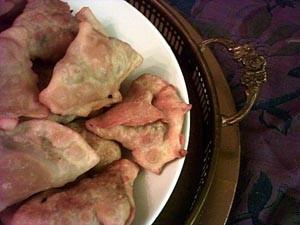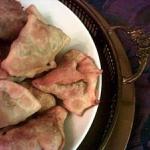Recipe: Lamb Filled Samosas
Lamb-Filled Samosas
Samosas are little deep fried pies filled with various meats and vegetables, and the key to success is in the shaping of the dough and the temperature of the frying oil.
Lamb Filling
1/2 pound lamb, ground or finely minced
1/3 cup onion, finely diced
1 teaspoon ginger root, finely shredded
2 cloves garlic, finely minced
1/2 teaspoon salt
1/8 teaspoon powdered saffron
1/2 teaspoon ground cumin
1/2 teaspoon ground coriander
2 tablespoons vegetable oil
Heat the vegetable oil in a large skillet. Add garlic, ginger and onion and sauté until just tender. Add lamb and sauté until lightly browned. Add saffron, cumin, coriander and salt. Stir to blend. Reduce heat and simmer for about 20 minutes, until liquid is evaporated, stirring occasionally, taking care not to over-brown the meat. Remove from heat and set aside to cool.
Variations: To this basic filling, you may also add or substitute potatoes (cooked and finely chopped), chopped spinach, and/or green peas.
Samosa Dough
1 1/2 cups flour
1/2 teaspoon salt
2 tablespoons ghee (see recipe)
1/2 to 3/4 cup water
Vegetable oil for deep frying
In a large mixing bowl, combine flour, salt and ghee. Mix with a fork until the dough resembles coarse meal. Gradually add water, stirring until the dough forms a ball and pulls away from the side of the bowl. Turn the dough onto a lightly floured board and knead for 10 minutes until the dough becomes smooth and elastic. Divide the dough into about fifteen 1" balls and cover with a slightly damp cloth to prevent drying. Roll each ball into a 4" circle and cut in half using a knife or pastry cutter. Using your fingers dipped in water, moisten the edges of each half-circle of dough. Fold the straight edge in half, overlap and press together to form a small cone. Cup the open cone of dough in your hand and fill with a teaspoon of the filling. Pinch the curved moistened edges of the cone together to form a small triangle pie. Set aside on a large plate or waxed paper and repeat with the remaining balls of dough.
Fill a frying pan or wok with about 3 inches of oil. Heat to 375 degrees, or until a pinch of dough sizzles and immediately rises to the top. When the oil is hot, gently slide the samosas into the pan, taking care not to overfill the pan. Each batch should be about 4 to 6 pieces. Using a pair of tongs, gently turn the samosas over until both sides just begin to turn golden brown. Remove immediately from the oil and drain on layers of paper towels. Working in batches of 4 to 6, repeat with the remaining samosas. The finished samosas may be kept warm on a baking sheet in a barely warm oven until ready to serve. Makes 30 pastries.
Ghee
This nutty, golden clarified butter is ubiquitous in Indian cuisine. And while it is a little labor intensive, it is well worth the effort, as it adds a unique flavor for which there is no adequate substitute.
1/2 pound butter
Gradually melt butter in a heavy saucepan over medium heat, making sure that the butter does not brown. When the butter is completely melted, increase the heat to high and boil until the surface is covered with thick foam. Reduce the heat to the very lowest setting, stir gently and simmer uncovered and undisturbed for 45 minutes. The milk solids will settle to the bottom of the pan and turn golden brown, while the clear butterfat rises to the top. Remove from the heat and allow to cool for 20 minutes. Pour the ghee into a jar through a fine sieve or cheesecloth to separate the residue from the clarified oil. Ghee may be stored in a tightly covered container in the refrigerator for several months. Under refrigeration, ghee will solidify and must be warmed to room temperature before using.
 ThingsAsian
ThingsAsian
















